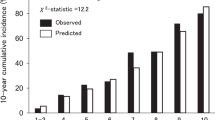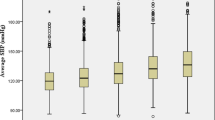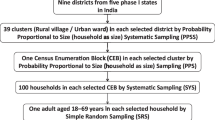Abstract
Type 2 diabetes mellitus (T2DM) and hypertension frequently occur together. We examined whether blood pressure (BP) levels predict 8-year incident diabetes. Participants were community-dwelling older adults who had BP measured twice and an oral glucose tolerance test at baseline and again 8.3 years later. At baseline, participants were classified as normotensive (systolic blood pressure (SBP) <120 mm Hg and diastolic blood pressure (DBP) <80 mm Hg; n=242); prehypertensive (SBP⩾120 and <140 mm Hg or DBP⩾80 and <90 mm Hg; n=426); or hypertensive (SBP⩾140 mm Hg or DBP⩾90 mm Hg or using anti-hypertensive medication; n=457). There were 1125 participants (mean age 66.0 years; 44.3% men) who attended the baseline and follow-up visit, of whom 85 had new onset T2DM. Participants who developed T2DM had higher mean body mass index (BMI) and BP levels than those who did not develop diabetes. In logistic regression models adjusted for age, sex, BMI, and physical activity, the odds of incident T2DM was greater in prehypertensives (odds ratio (OR) 2.32 95% confidence interval (CI) 1.05–5.1, P=0.03) and hypertensives (OR 3.5 95% CI 1.50–8.0, P=0.002) compared with normotensives. Excluding participants who used anti-hypertensive medications did not change results. In conclusion, mid-life hypertension and prehypertension predicted future diabetes, independent of BMI. Glucose surveillance should be encouraged in adults with prehypertension or hypertension.
This is a preview of subscription content, access via your institution
Access options
Subscribe to this journal
Receive 12 digital issues and online access to articles
118,99 € per year
only 9,92 € per issue
Buy this article
- Purchase on SpringerLink
- Instant access to full article PDF
Prices may be subject to local taxes which are calculated during checkout


Similar content being viewed by others
References
Chobanian AV, Bakris GL, Black HR, Cushman WC, Green LA, Izzo Jr JL et al. The seventh report of the joint national committee on prevention, detection, evaluation, and treatment of high blood pressure: the JNC 7 report. JAMA 2003; 289: 2560–2572.
Ford ES, Giles WH, Dietz WH . Prevalence of the metabolic syndrome among US adults: findings from the third National Health and Nutrition Examination Survey. JAMA 2002; 287: 356–359.
Conen D, Ridker PM, Mora S, Buring JE, Glynn RJ . Blood pressure and risk of developing type 2 diabetes mellitus: the Women′s Health Study. Eur Heart J 2007; 28: 2937–2943.
Meisinger C, Doring A, Heier M . Blood pressure and risk of type 2 diabetes mellitus in men and women from the general population: the monitoring trends and determinants on cardiovascular diseases/cooperative health research in the Region of Augsburg cohort study. J Hypertens 2008; 26: 1809–1815.
Barrett-Connor E . The prevalence of diabetes mellitus in an adult community as determined by history or fasting hyperglycemia. Am J Epidemiol 1980; 111: 705–712.
American Diabetes Association. Diagnosis and classification of diabetes mellitus. Diabetes Care 2009; 32 (Suppl 1): S62–S67.
Hypertension detection and follow-up group. The hypertension detection and follow-up program: hypertension detection and follow-up program cooperative group. Prev Med 1976; 5: 207–215.
Friedewald WT, Levy RI, Fredrickson DS . Estimation of the concentration of low-density lipoprotein cholesterol in plasma, without use of the preparative ultracentrifuge. Clin Chem 1972; 18: 499–502.
Bonora E, Targher G, Alberiche M, Bonadonna RC, Saggiani F, Zenere MB et al. Homeostasis model assessment closely mirrors the glucose clamp technique in the assessment of insulin sensitivity: studies in subjects with various degrees of glucose tolerance and insulin sensitivity. Diabetes Care 2000; 23: 57–63.
Izzo R, de Simone G, Chinali M, Iaccarino G, Trimarco V, Rozza F et al. Insufficient control of blood pressure and incident diabetes. Diabetes Care 2009; 32: 845–850.
Ferrannini E, Buzzigoli G, Bonadonna R, Giorico MA, Oleggini M, Graziadei L et al. Insulin resistance in essential hypertension. N Engl J Med 1987; 317: 350–357.
DeFronzo RA, Ferrannini E . Insulin resistance. A multifaceted syndrome responsible for NIDDM, obesity, hypertension, dyslipidemia, and atherosclerotic cardiovascular disease. Diabetes Care 1991; 14: 173–194.
Asch S, Wingard DL, Barrett-Connor EL . Are insulin and hypertension independently related? Ann Epidemiol 1991; 1: 231–244.
Anneren C, Welsh M, Jansson L . Glucose intolerance and reduced islet blood flow in transgenic mice expressing the FRK tyrosine kinase under the control of the rat insulin promoter. Am J Physiol Endocrinol Metab 2007; 292: E1183–E1190.
Song Y, Manson JE, Tinker L, Rifai N, Cook NR, Hu FB et al. Circulating levels of endothelial adhesion molecules and risk of diabetes in an ethnically diverse cohort of women. Diabetes 2007; 56: 1898–1904.
Meigs JB, Hu FB, Rifai N, Manson JE . Biomarkers of endothelial dysfunction and risk of type 2 diabetes mellitus. JAMA 2004; 291: 1978–1986.
Jiang X, Sheng H, Li J, Xun P, Cheng Y, Huang J et al. Association between renin-angiotensin system gene polymorphism and essential hypertension: a community-based study. J Hum Hypertens 2009; 23: 176–181.
Feng Y, Niu T, Xu X, Chen C, Li Q, Qian R et al. Insertion/deletion polymorphism of the ACE gene is associated with type 2 diabetes. Diabetes 2002; 51: 1986–1988.
Stephens JW, Dhamrait SS, Cooper JA, Acharya J, Miller GJ, Hurel SJ et al. The D allele of the ACE I/D common gene variant is associated with Type 2 diabetes mellitus in Caucasian subjects. Mol Genet Metab 2005; 84: 83–89.
Conen D, Glynn RJ, Buring JE, Ridker PM, Zee RY . Renin-angiotensin and endothelial nitric oxide synthase gene polymorphisms are not associated with the risk of incident type 2 diabetes mellitus: a prospective cohort study. J Intern Med 2008; 263: 376–385.
Conen D, Glynn RJ, Buring JE, Ridker PM, Zee RY . Association of renin-angiotensin and endothelial nitric oxide synthase gene polymorphisms with blood pressure progression and incident hypertension: prospective cohort study. J Hypertens 2008; 26: 1780–1786.
Acknowledgements
The Rancho Bernardo Study was funded by the National Institutes of Health/National Institute on Aging grant AG07181 and grant AG028507 and the National Institute of Diabetes and Digestive and Kidney Diseases, grant DK31801. CKK was a recipient of a grant from Coordenacao de Aperfeicoamento de Pessoal de Nivel Superior (CAPES) Brazil (Programa de Doutorado no Pais com Estagio no Exterior [PDEE] sandwich).
Author information
Authors and Affiliations
Corresponding author
Ethics declarations
Competing interests
The authors declare no conflict of interest.
Rights and permissions
About this article
Cite this article
Kramer, C., Mühlen, D. & Barrett-Connor, E. Mid-life blood pressure levels and the 8-year incidence of type 2 diabetes mellitus: the Rancho Bernardo Study. J Hum Hypertens 24, 519–524 (2010). https://doi.org/10.1038/jhh.2009.103
Received:
Revised:
Accepted:
Published:
Issue Date:
DOI: https://doi.org/10.1038/jhh.2009.103
Keywords
This article is cited by
-
Insulin Resistance the Hinge Between Hypertension and Type 2 Diabetes
High Blood Pressure & Cardiovascular Prevention (2020)
-
High-normal blood pressure and long-term risk of type 2 diabetes: 35-year prospective population based cohort study of men
BMC Cardiovascular Disorders (2012)
-
Family history of diabetes modifies the effect of blood pressure for incident diabetes in Middle Eastern women: Tehran Lipid and Glucose Study
Journal of Human Hypertension (2012)
-
Accuracy of Anthropometric Indexes of Obesity to Predict Diabetes Mellitus Type 2 Among Men and Women With Hypertension
American Journal of Hypertension (2011)
-
Diabetic heart disease: the story continues
Journal of Human Hypertension (2011)



